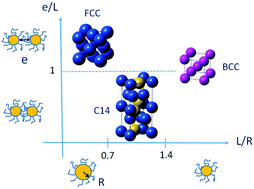Softness-driven complexity in supercrystals of gold nanoparticles†
Abstract
Many soft matter systems are composed of roughly spherical objects that can self-assemble in ordered structures. Unlike hard spheres, at high volume fraction these soft spheres adapt their shape to the local geometrical constraints and the question of space filling needs to be entirely revisited. Hydrophobically coated gold nanocrystals self-assemble in supercrystals and are good candidates to explore this question. When the soft coating is thin compared to the rigid core, a FCC structure is obtained, with a behaviour similar to that of hard spheres. In the opposite case, for a thick soft coating, a BCC structure is found instead. This paper focus on the intermediate region between these two classical structures. By varying the gold core radius R and the ligand fully extended length L, we establish a structure diagram based on a large experimental data set. The hexagonal Frank–Kasper C14 structure is observed for various values of R and L and can coexist with a FCC phase. Depending on the structure, values of the minimum thickness e of the ligand shell compared to L are different. These experimental results confirm that the C14 Frank–Kasper phase is a solution to the problem of filling the space with soft particles even with a rigid core and should help to establish pertinent models in order to predict the structures of the superlattices built by gold nanoparticles.



 Please wait while we load your content...
Please wait while we load your content...